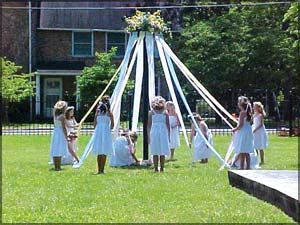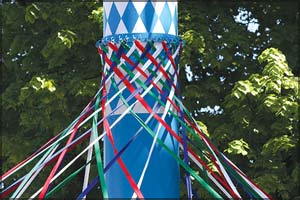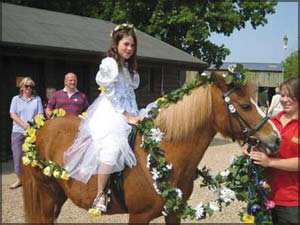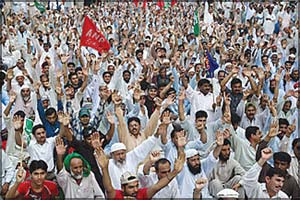
May Day becomes Labour Day
The first of May is printed in red in your calendar, and marked May
Day. Some calendars have added information: Public Bank and Mercantile
Holidays.
|

Dancing around the May Pole. |
Why is the first of May named May Day?
The first of May is, in our country and many other countries the
world over, called Labour Day or the Workers’ Day, and trade unions,
factory workers and other men and women working in other places like the
harbour, and tea plantations, come out on to the streets, shouting
slogans, airing their grievances and making their demands. They march in
procession and hold meetings in public grounds like parks.
It is their day, the Workers’ Day, a day set apart for them, just as
you children have October first set apart for you, and October 6 for
your teachers.
How come that this day set apart for the workers of the world is
designated (named) May Day?
Long, long before May Day became the Workers’ Day, it was a holiday
celebrated in various ways in various countries of Europe.
|

The ribbons being woven in a design around the pole . |
May Day is the first day in the fifth month of the year - the third
in the old Roman calendar. I explained about this in the March 1 issue
of the Junior Observer. The month was named in honour of the Greek
Goddess Maia.
She was not a famous goddess like Juno, whose name has been given to
the following month, but, she had a famous father Atlas, who, in Greek
mythology is said to carry the world on his shoulders.
The name rings a bell, doesn’t it? The book of maps in your school
bag, has been given that name, because this giant of a god held up the
world on his shoulders. Maia also had a famous son, Hermes, the
messenger of the gods.
In course of time, Maia got identified with a Roman goddess, Flora,
the goddess of growth and spring, of fruits and flowers. The Romans had
a festival on the first day of the month named Maia.
The custom of celebrating the first day of the ‘month of fruits and
flowers’ was observed in other countries too. In England, May Day was a
festive occasion in the villages.
The people gathered on the village ‘Green’ to elect a May Queen, the
same as we elect an ‘Avurudu Kumari’. The girls and boys danced round a
May Pole. The pole was painted and decorated with flowers and ribbons.
The children danced round the May Pole each holding a ribbon.
|

A May Queen going on a parade. |
The May Pole dance and the election of the May Queen has come down to
this day. At one time in days gone by, when your grandmother was in
school, our school girls too did the May Pole dance, but not on the
first of May as part of May Day celebrations.
How and when did May Day become ‘Workers’ Day? I looked up an
encyclopedia and this is what it says: “The American Federation of
Labour named May 1 1886, as the date on which intensive agitation for
the eight hour day would begin.”
For sometime before this date, factory workers in America were
grumbling about and protesting against the long hours of work and
demanding shorter working hours. Women were in the forefront of this
agitation.
|

A May Day rally. |
The encyclopedia states further: “This established May Day as a
labour day, widely observed by strikes, demonstrations, parades,
speeches, and other activities. Violent clashes with the police often
occurred.
“The International Workingmen’s Congress in Paris in 1889 urged
world-wide demonstrations for the eight-hour day on the following first
of May. (that is in May 1890). This identified May Day as an
international labour holiday.” (New Standard Encyclopedia).
So, this is how May Day became Labour Day. It was the Russian
Revolution of 1917 that gave a push to the May Day celebrations in
Russia. The annual celebrations on May Day was an important event in
Communist countries from China through East Europe to Cuba.
In Sri Lanka, May Day was first celebrated in 1956, shortly after
S.W.R.D. Bandaranaike formed his government in April 1956. T.B.
Illangarathna, the Minister for Labour in the new cabinet declared May 1
a worker’s holiday, since then May 1 is celebrated as the Workers Day or
Labour Day and it is also a Public, Bank and Mercantile Holiday.
- Sumana Saparamadu |

